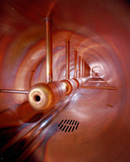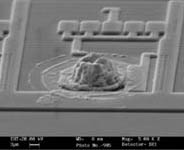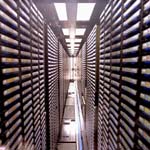|
Bold new tools to study matter, space and time
Like explorers embarking on new territory, physicists need the right equipment to explore the microcosm. Only by pushing the frontiers of technology, can physicists probe nature's deepest secrets and enter the realm of discovery.
High-energy physicists rely on four essential scientific tools:
- powerful accelerators to create high-energy particle collisions
- superconducting magnets with advanced materials and design to guide particle beams
- sophisticated particle detectors with superfast readout technology to observe and record particle collisions
- innovative computing solutions to store, access and analyze huge quantities of data
Fermilab collaborates closely with scientists from industry and universities around the world to advance all of these fields. The R&D projects spur the development of new technology in many other areas, including cooling-systems design, vacuum technology, electrical engineering
and precision surveying methods. New technical solutions benefit disciplines such as medicine, astronomy, materials science and computer science.
Highlights at Fermilab
 |
Interior of Fermilab's linear accelerator. |
- Operation of the world's most powerful proton-antiproton collider facility
Fermilab successfully operates the world's highest-energy particle accelerator and
its only proton-antiproton collider. Particle physicists from U.S. and foreign
universities use Fermilab to carry out high-energy physics research.
- Accelerator design, construction, and operation
Fermilab's internationally recognized excellence in innovative accelerator R&D is
the foundation for development of more advanced accelerator concepts, leading to
the tools necessary to find the answers to fundamental questions about matter,
space and time.
- Superconducting magnet research, design, and development
Fermilab is a world leader in the successful development of superconducting
magnets, the bedrock technology for increasing the energy of proton accelerators.
 |
Sitting on top of an electronic chip, this microscopic bump will connect the chip with a silicon pixel detector. |
- Detector development
Fermilab's CDF and DZero detectors are the most powerful particle detectors ever
built. Advances in technology, such as silicon detectors, continue to improve the
world's most powerful microscopes to carry out the experiments of the future.
- High-performance computing
To record and analyze the data generated in particle physics, Fermilab has pushed
the limits of computing and made key contributions to the next generation of the
nation's computers. Fermilab is recognized for experience in handling huge amounts of data, pioneering success in parallel computing and willingness to try technically risky new directions.
 |
In order to make data quickly accessible, Fermilab uses robotic systems to retrieve magnetic tape cartridges.
(Click on image to enlarge.) |
- Accelerators for medical applications
Fermilab has built the particle accelerators used by cancer treatment centers. The
linear accelerator at Fermilab creates the neutron beam used by the Midwest
Institute for Neutron Therapy. Since 1976, this facility has treated more than 3,000
cancer patients. The Proton Treatment Center in Loma Linda, California features a proton accelerator built at Fermilab in 1988-89. In ten years of operation, the center treated almost 6,000 cancer patients. In honor of this accomplishment, FermiNews published an article.
Slide show on some technology spin offs from high energy physics
Accelerator Science in Medicine
Homepage of Technical Division
|





